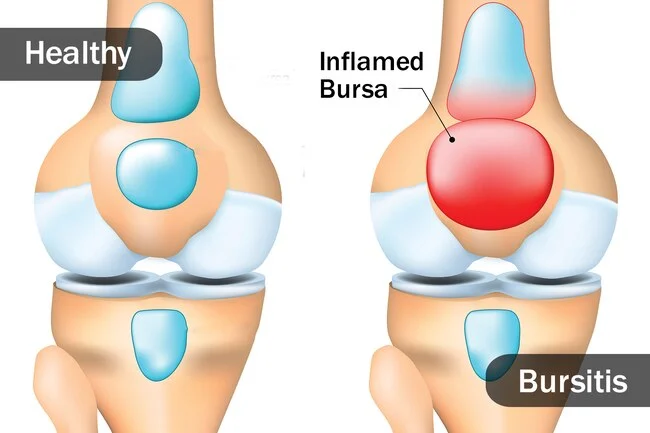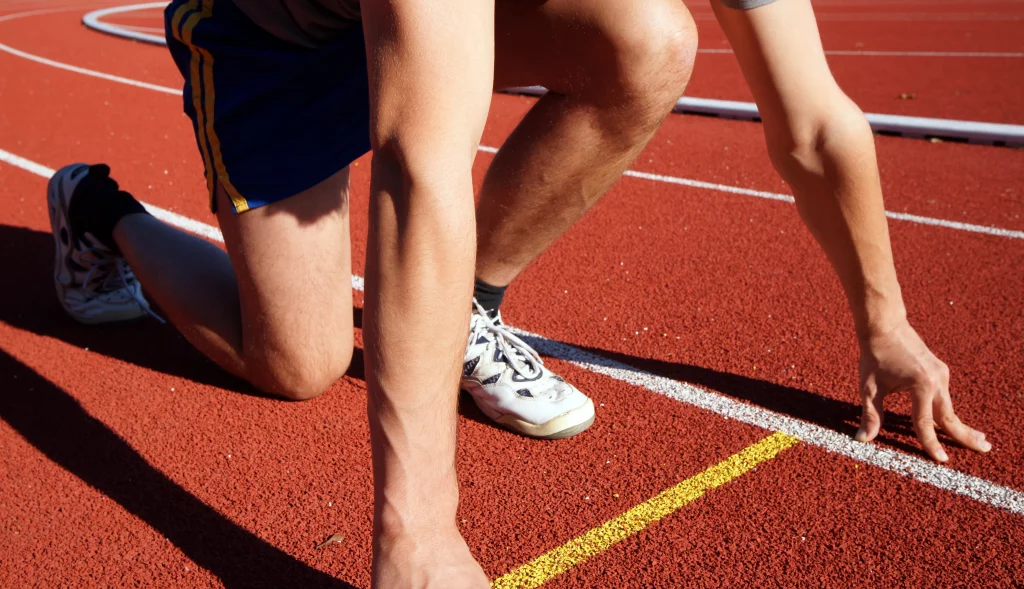Bursitis is a disease that causes pain and inflammation in various different joints found throughout the body. It can limit the use of a limb and cause significant inconvenience when it occurs in a joint that is in constant use, or for those whose work includes repeated physical activity of a certain kind.
Traditional treatments are not always effective and can have significant side effects which limits their repeated use. This can cause significant issues for patient quality of life. Thankfully, a recently discovered treatment known as platelet rich plasma therapy has been shown to produce more effective and longer lasting results than previous methods.
What is Bursitis?
Fluid filled sacs, known as bursa, are located within the body around the major joints. These sacs provide cushioning to the joints and reduce the friction between them, allowing improved motion of the joint they surround. Obviously, these sacs are important for a variety of daily activities.
When a particular joint is used excessively or is damaged through a sudden extreme impact, these sacs may become inflamed, causing swelling, pain, and irritation. The condition is particularly common in people over the age of 40, and in those who carry out similar motions using a particular joint very frequently, or who put a lot of pressure on the same joint for a long period of time. Examples of such activities are gardening, construction, and many sports such as tennis or skiing.
If joints or the surrounding areas are damaged, then bursitis may be more likely to occur since the bursae are under more pressure due to the lack of surrounding supportive tissues. The disease can also be caused by an injury or through an infection, although this is less likely.
Though the condition is likely to flare up when a particular joint is overused, those who suffer from the condition are more likely to repeatedly experience the symptoms. Usually the patient is advised to rest and reduce the amount they are using the joint. Of course, for those who use the joint as part of their livelihood, this is a huge problem.
There Are Several Types of Bursitis
Bursitis may develop in any of the bursae found throughout the body, but there are some locations where it occurs more commonly than others. This is due to the fact that some joints are used more commonly and with greater pressure than others.
Achilles tendon
Bursitis in the Achilles tendon is known as Albert’s disease or Haglund’s deformity, depending on whether it occurs at the front or at the back of where the Achilles tendon attaches to the heel. This is most commonly caused by injury or wearing shoes with too hard of a back or that applies too much pressure to the back of the foot. It is common in young women who wear high heeled shoes frequently and for extended periods of time.
Hip
Bursitis in the hip is one of the most common forms of bursitis due to the degree to which the hip is used in everyday life. It is more common in women than in men and tends to appear even without excessive or improper use of the joint.
Knee and kneecap
Individuals who spend a significant amount of time resting their weight on their knees or shins can develop bursitis in their knees. This is particularly common amongst professionals such as gardeners or plumbers, who spend significant time doing work at ground level.
Current Methods Don’t Solve the Underlying Issue
There are a number of treatments currently in use for those who suffer from bursitis, but none of them fix the underlying condition. Collectively they attempt to reduce the inflammation and associated pain, or to reduce the chance or severity of flare-ups in the future.
Anti-Inflammatory Drugs
There are a wide variety of medications that may be prescribed to relieve the pain experienced by a bursitis patient and reduce the inflammation that appears in the joints. Collectively referred to as Nonsteroidal anti-inflammatory drugs, or NSAIDS, these work by reducing the body’s natural inflammatory response that is overactive in the case of bursitis. They can provide temporary relief but do not address the cause of bursitis, and long-term use of NSAIDS can have side-effects, particularly when used in conjunction with other medications. This could leave patients in a worse position than before the medication.
Physical Therapy
For patients who need to keep using their joints in a manner that exacerbates their bursitis, physical therapy is often prescribed. The patients can then work with a physical therapist to develop a regimen of exercises used to improve the strength of the joints and muscles around the affected area, to reduce the irritation caused by overuse and increase the tolerance of the joints. This does not solve the underlying condition of the damaged sacs.
Cortisone Shots
Very commonly used to treat joint problems such as bursitis and arthritis where damage to the joints leads to pain and inflammation, an injection of cortisone into the affected area can reduce the levels of inflammation in the joint. The relief provided might be permanent or temporary depending on the patient, but repeated injections are not recommended since over time, excess exposure to cortisone can lead to damage to the cartilage or bone around the injection site.
Cortisone shots are the most effective form of traditional treatment for bursitis. Though very effective in the short term, in the longer term the treatment often wears off and patients find themselves no better off than they were before they started treatment. Cortisone shots can actually cause more harm in the long term. The sacs will continue to become damaged as patients will continue to perform the activities that caused the harm in the first place.
Bursa Removal
If all else fails, any bursae that continue to become inflamed over time may ultimately be removed through surgery. Some joints, such as the hip, are able to function relatively normally without the added cushioning provided by the bursa. If these are the areas being affected by bursitis, then surgical removal may be an option to prevent the continual inflammation. Though the surgery is relatively minor and does not usually require an overnight hospital stay, it still has risks and side-effects that need to be carefully considered before committing to a surgical option.
Although traditional treatments are often successful at reducing the amount of pain and inflammation, they are limited to treating the symptoms in the short term. Fortunately, recent developments in regenerative medicine have led to a new form of treatment for bursitis – platelet rich plasma, or PRP therapy.
How Does PRP Help With Bursitis?
Platelet rich plasma is a treatment that involves taking a small amount of a patient’s own blood and then separating it out into its constituent pieces by spinning it in a centrifuge. Once the blood has been separated out, certain key elements are extracted from the mixture and re-injected into the treatment site.
The parts of the blood used in PRP therapy are the plasma, which is the liquid component of the blood that contains the dissolved chemicals, and the platelets, which are small cell fragments that are carried in the bloodstream. These platelets help detect and repair damaged tissues by binding them together and producing growth factors that stimulate the body’s own healing and repair response.
When treating bursitis, the platelet rich plasma is extracted from the patient and then injected directly into the inflamed bursae. Since joints have a relatively low blood supply, they naturally have limited quantities of platelets and the corresponding growth factors and hormones. By injecting more directly into the bursae, the body increases its natural healing response, reducing the inflammation of the bursae and potentially healing underlying damage that may be causing the inflammatory response.
The bursae will actually repair itself, there is no other current treatment that can make that claim. There is a growing amount of evidence that shows that PRP therapy is an effective treatment for bursitis.
The Evidence Shows That PRP is More Effective Than Cortisone Shots
A study presented to the American Academy of Orthopaedic Surgeons at a conference in 2014 investigated the use of platelet-rich plasma injections compared to cortisol injections, which was the most effective technique available at the time.
The study took 40 patients and split them into two groups at random, one of whom was treated with the standard cortisol treatment while the other was treated with a single injection of platelet rich plasma. The study investigated the changes in functionality of the hips of patients who received the two different treatments using two different measures of functionality: the Harris Hip Score (HHS) and Western Ontario and McMaster Universities Arthritis Index (WOMAC). The HHS focuses purely on functionality, while the WOMAC also considers measures of pain and stiffness.
The results of the study were very promising. While both groups of patients had very similar scores on both scales before treatment, three months after treatment the patients who received the cortisone treatment improved their HHS scores by around 50% and their WOMAC scores by about 30%. On the other hand, the patients who received the platelet rich plasma treatment improved their HHS scores by 70% and their WOMAC scores by around 50%, significantly higher improvements than those treated with cortisone.
More than just this initial superior level of improvement in the patients who received platelet rich plasma treatments, these patients also maintained this improvement in the long term. The study showed that one year after treatment, the cortisone patients lost a significant amount of their initial improvement, ending up with scores only around 10% higher on both the HHS and WOMAC scales at one year after the initial treatment. The platelet rich plasma patients on the other hand, ended up with scores one year on that were almost equal to the scores 3 months after treatment.
This study shows that this new approach to treating bursitis can be not only more effective than traditional treatments, but can also provide a longer-lasting relief that other treatments lack.
As well as this individual study, a literature review was carried out by scientists to assess the success of platelet rich plasma treatments for bursitis. This review looked at all available studies on this kind of treatment that were available to them and aggregated the data to look for results. This kind of approach can solve the problem of individual studies having small sample sizes or other potential flaws, by looking at data taken using a number of different methods.
The authors of the review found that treatments with platelet rich plasma for bursitis located in the hip were successful and produced improvements both 3 months after the initial treatment, which were maintained when patients were followed up with a year on. This demonstrates that the original study was not a one-off event, but that using platelet rich plasma therapy to treat patients with bursitis can be a highly effective treatment for many different individuals.
Clearly there is evidence that using platelet rich plasma to treat bursitis is successful, and it has been well-established in the literature that the nature of the treatment, using a patient’s own blood, makes it a relatively self and non-invasive treatment as well. It is therefore an excellent option for those who suffer from this condition.
Reach out to the BioXcellerator team to learn more about how PRP therapy can help you with your bursitis. Our team will recommend the best course of treatment for you and your unique case. Your quality of life will greatly improve with PRP therapy.


